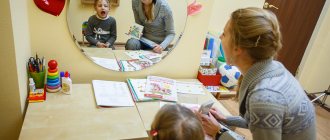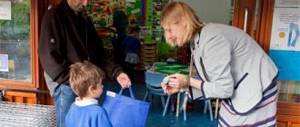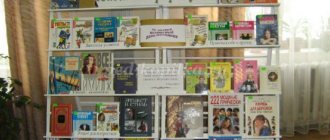Defectological representation of a student with intellectual disabilities
Defectological representation of the student
Full Name:
student
Date of Birth:
03/24/2008 (9 years, 9 months)
School №_3_grade 2 "a"
Emotional response in an examination situation:
makes contact with teachers easily, has a positive attitude towards the examination situation, praise creates a situation of success, orderly behavior, is not critical of the results of his own activities (does not notice his own mistakes, corrects them when pointed out).
Development of gross and fine motor skills:
the development of general motor skills is close to the age norm, the development of fine motor skills is low (he draws, colors carelessly, often goes beyond the outline of the drawing, the pressure is weak).
Learning ability:
Learning Ability:
able to work according to a model, instructions, independently
,
receptivity to help
: accepts the help of a teacher, depending on the type of activity, needs stimulating, organizing, guiding and teaching assistance.
The method of action shown partially transfers to similar tasks.
Features of the organization of activities, the formation of regulatory functions
Accepts the task, cognitive activity is not formed, cognitive interest in the task is maintained with stimulating help in the form of a positive emotional mood, difficulties in work do not cause negative emotions, and overcomes with explanation. Doesn't plan his activities
Work pace:
low, the decrease is associated with the characteristics of the emotional-volitional sphere.
Performance:
insufficient (does not follow the algorithm of tasks, gets tired quickly while working on tasks).
Not critical of the results of his own activities (does not notice his own mistakes, corrects them when pointed out).
General stock of ideas/knowledge:
Knowledge and ideas about oneself and family are below the age norm. He gives his first and last name, knows his age, but doesn’t know his date of birth. He does not give his home address. General ideas about the world around us do not meet age requirements (knows the seasons and their sequence, does not know the names of the months, names the days of the week with help. The concept of “yesterday” is not formed, “today, tomorrow” is understood. Knows the name of the country, but does not have the capital. Animals names, but does not differentiate between wild and domestic, names vegetables and fruits, but does not differentiate, pieces of furniture, vehicles in pictures, recognizes and names.
Formation of spatio-temporal representations:
Orientation skills in space and time are not sufficiently developed, he can determine the right-left hand, in space he cannot independently determine the right-left side, he is partially oriented on a sheet of paper. A graphic image of an object is copied by cells using. Collects cut-out pictures from 4 parts (vertical-horizontal). In the school premises he orients himself independently.
Peculiarities of perception
:
Visual perception is impaired: the perception of superimposed (3 out of 5), crossed out images is difficult, and does not recognize half-drawn images.
The main colors are distinguished, the difficulty is the difference in shades of colors.
Understanding instructions received by ear:
understands instructions after repeated repetition and explanation.
Features attention:
attention is unstable, distracted by external stimuli, incapable of long-term focus and concentration on work. Distribution difficulties, slow switchability.
Memory Features:
low productivity of memorization, indirect memorization (3 out of 6), upon repeated presentation 4 out of 6. The volume of auditory-verbal memorization is reduced (2 out of 10).
Level of development of mental operations:
Generalization and exclusion are carried out unevenly, according to essential features (only in mild cases). The fourth extra one highlights in the pictures, according to the main features, organizing assistance is needed at the stage of speech generalization of the highlighted features.
The classification was not carried out in full, he takes help, explains his choice with help. When carrying out subject classification, he correctly understands the instructions, is in a hurry, is distracted, organizational help is needed. He has not fully established logical connections between phenomena and objects (simple non-verbal analogies), it is necessary stimulating and guiding help from an adult.
I laid out a series of plot pictures and composed a story using leading questions.
Formation of study skills
Partially assimilates program material in academic subjects at a minimum level.
Mathematics:
Knows basic geometric figures. Mechanical counting within 15, counting backwards is not mastered, does not correlate the number and quantity of objects, does not establish the relationship “more” “less”. Names and writes numbers. Addition and subtraction within 5 are performed using visual material with teaching assistance.
- typical mistakes: inattentive.
Russian language:
- calligraphic writing skill: not sufficiently developed.
Features of speech development:
SNR of moderate severity.
General sound of speech:
the speaking voice is quiet, the pace of speech is slow. Speech is intelligible.
Lexicon:
The active vocabulary is represented by everyday topics.
Connected speech:
not formed enough. A story based on a plot picture is characterized by a violation of the coherence of the presentation; low information content; poverty of lexical and grammatical means of the language; difficulties in the linguistic implementation of the plan.
General characteristics of educational activities
: the actual educational motivation is reduced, the level of independent work is low, the plannedness of activities, self-control, and arbitrariness are disrupted.
Conclusion:
The general stock of ideas and knowledge is below the age norm. Receptive to help, needs stimulating, organizing, directing and teaching assistance, step-by-step adult control. Instructions perceived by ear are understood after repetition and explanation. Low productive memorization. Incapable of long-term concentration and concentration on work. Low level of mental operations.
Insufficient development of educational skills. Own educational motivation is reduced, low level of independent work, inability to exert volition, the regularity of activities, self-control and volition are impaired.
The pace of work is low, efficiency is insufficient.
Directions of correctional work:
- Development of arbitrariness of mental activity;
- Development of mnestic processes;
- Development of grapho-motor functions;
- Development of temporal representations;
- Development of mathematical concepts;
- Development of speech activity;
- Development of thinking.
- Monitoring in December, passing the CPMPK in order to determine the further educational route (clarification of the AOEP option)
Completion date September
Defectologist_______________________
Defectological presentation on student material on the topic
Defectological representation for a first grade student
(first half of the year)
Full Name_________________________________________________________
Date of Birth_________________________________________________________________
School No. ________________ class ________________________________________________
Emotional response in an examination situation (contact, manifestations of negativism, reaction to failure, praise, the presence of affective reactions)__________________________
______________________________________________________________________________
______________________________________________________________________________
Development of gross and fine motor skills________________________________________________
______________________________________________________________________________
______________________________________________________________________________
Understanding of instructions perceived by ear (understands immediately, after repetition, after explanation, does not understand)__________________________________________________________________________
_______________________________________________________________________________
_______________________________________________________________________________
Learning ability:
- receptivity to help (stimulating, organizing, guiding, teaching assistance)_________________________________________________________________________
— ability to transfer to similar tasks ________________________________________________
________________________________________________________________________________
Features of the organization of activities, the formation of regulatory functions (purposeful activity, the presence of an indicative stage, the use of rational methods of action, impulsiveness/inertia of actions, self-control)____
_________________________________________________________________________________
_________________________________________________________________________________
_________________________________________________________________________________
_________________________________________________________________________________
Pace of work (on educational and non-educational material)_____________________________________________
_________________________________________________________________________________
_________________________________________________________________________________
Performance (in individual and frontal classes)______________________________
__________________________________________________________________________________
__________________________________________________________________________________
General awareness and social and everyday orientation________________________________
__________________________________________________________________________________
__________________________________________________________________________________
__________________________________________________________________________________
Formation of spatio-temporal representations___________________________
__________________________________________________________________________________
__________________________________________________________________________________
Peculiarities of perception (visual perception, auditory-motor coordination, stereognosis) ___________________________________________________________________________________
__________________________________________________________________________________
__________________________________________________________________________________
__________________________________________________________________________________
Features of attention______________________________________________________________
__________________________________________________________________________________
Features of memory ________________________________________________________________________________ ________________________________________________________________________________________________________________________________________________________________________________________________________________________________________________________________
Features of thinking:
— level of development of visual forms of thinking _________________________________________________
____________________________________________________________________________________
____________________________________________________________________________________________________________________________________________________________________________________________________________________________________________________________
— the formation of the prerequisites for verbal and logical thinking _________________________
____________________________________________________________________________________________________________________________________________________________________________________________________________________________________________________________
Features of constructive activity ______________________________________________
____________________________________________________________________________________
____________________________________________________________________________________
General characteristics of speech development ________________________________________________
____________________________________________________________________________________________________________________________________________________________________________________________________________________________________________________________
Level of readiness for schooling ______________________________________________
____________________________________________________________________________________________________________________________________________________________________________________________________________________________________________________________________________________________________________________________________________________________________________________________________________________________________________________________________________________________________________________________________________________________________________________________________________________________________________________________________________________________________________________________________________________________________________________
The formation of the prerequisites for educational activity (the ability to organize one’s activity, the degree of interest in the task, the characteristics of cognitive activity, the ability to act according to instructions, work in accordance with a model, the ability to accept and retain a learning task)______________________________________________________________________________
____________________________________________________________________________________
________________________________________________________________________________________________________________________________________________________________________________________________________________________________________________________________________________________________________________________________________________
Conclusion _________________________________________________________________________
________________________________________________________________________________________________________________________________________________________________________
____________________________________________________________________________________
Planned activities of the specialist_______________________________________________________________
____________________________________________________________________________________
________________________________________________________________________________________________________________________________________________________________________
Date of examination______________________________________________
Signature of the specialist ______________________________________________
Defectological representation per student
(grades 1–4)
Full Name_________________________________________________________
Date of Birth_________________________________________________________________
School No. ________________ class ________________________________________________
Emotional response in an examination situation (contact, manifestations of negativity, reaction to failure, praise, the presence of affective reactions)______________
______________________________________________________________________________
______________________________________________________________________________
Development of gross and fine motor skills________________________________________________
______________________________________________________________________________
______________________________________________________________________________
Understanding of instructions, perceived by ear and read independently (understands immediately, after repetition, after explanation, does not understand)_________________________________
_______________________________________________________________________________
_______________________________________________________________________________
Learning ability:
- receptivity to help (stimulating, organizing, guiding, teaching assistance)_________________________________________________________________________
— ability to transfer to similar tasks ________________________________________________
________________________________________________________________________________
Features of the organization of activities, the formation of regulatory functions (purposeful activity, the presence of an indicative stage, the use of rational methods of action, impulsiveness/inertia of actions, self-control)____
_________________________________________________________________________________
_________________________________________________________________________________
_________________________________________________________________________________
_________________________________________________________________________________
Pace of work (on educational and non-educational material)_____________________________________________
_________________________________________________________________________________
_________________________________________________________________________________
Performance (in individual and frontal classes)______________________________
__________________________________________________________________________________
__________________________________________________________________________________
General awareness and social and everyday orientation________________________________
__________________________________________________________________________________
__________________________________________________________________________________
__________________________________________________________________________________
Formation of spatio-temporal representations___________________________
__________________________________________________________________________________
__________________________________________________________________________________
Peculiarities of perception (visual perception, auditory-motor coordination, stereognosis) ___________________________________________________________________________________
__________________________________________________________________________________
__________________________________________________________________________________
__________________________________________________________________________________
Features of attention______________________________________________________________
__________________________________________________________________________________
Memory features ________________________________________________________________ _____________________________________________________________________________________________________________________________________________________________________
Features of thinking:
— level of development of visual forms of thinking __________________________________________
__________________________________________________________________________________
__________________________________________________________________________________
- verbal and logical thinking _____________________________________________________
__________________________________________________________________________________
Features of constructive activity_____________________________________________
__________________________________________________________________________________
__________________________________________________________________________________
General characteristics of speech development_______________________________________________
____________________________________________________________________________________________________________________________________________________________________
Formation of educational skills:
Mathematics
— formation of the concepts of number, number sequence____________________
__________________________________________________________________________________
— computing skill ____________________________________________________________
- problem solving skills ______________________________________________________________
— typical errors ______________________________________________________________
__________________________________________________________________________________
Russian language:
— calligraphic writing skill ___________________________________________________
- skill of spelling writing under dictation__________________________________________
__________________________________________________________________________________
— copying text ________________________________________________________________
— completing grammar tasks_________________________________________________
— typical errors ______________________________________________________________
__________________________________________________________________________________
Reading:
— reading pace______________________________________________________________________________
- way of reading_________________________________________________________________________
- reading comprehension _________________________________________________________________
- skills in working with text_________________________________________________________________
- typical errors_______________________________________________________________
__________________________________________________________________________________
General characteristics of educational activities (motivation, methods of educational work)_________
__________________________________________________________________________________
__________________________________________________________________________________
Conclusion _______________________________________________________________________
____________________________________________________________________________________________________________________________________________________________________
__________________________________________________________________________________
Planned activities of the specialist_______________________________________________
__________________________________________________________________________________
Date of examination_______________ Signature of specialist
Defectological representation per student
(5-9 grade)
Full Name_____________________________________________________________
Date of Birth_____________________________________________________________________
School No. ________________ class ___________________________________________________
Behavior in an examination situation, features of the emotional-volitional sphere (contact, the prevailing mood background, the ability to regulate behavior and comply with the requirements, arbitrariness) __________________________________________
__________________________________________________________________________________
__________________________________________________________________________________
__________________________________________________________________________________
__________________________________________________________________________________
Nature of activity and performance (purposefulness and organization of activity, ability to work concentratedly for a long time, general pace and productivity of activity, time for signs of fatigue to appear, ability to exert volition when difficulties arise, self-control) _________________________
__________________________________________________________________________________
__________________________________________________________________________________
__________________________________________________________________________________
__________________________________________________________________________________
General characteristics of learning ability (understanding of instructions for a task, awareness of a learning task, ability to deliberately remember, concentrate and maintain active attention, persistence of learning interest, need for help) _________________
__________________________________________________________________________________
__________________________________________________________________________________
__________________________________________________________________________________
COGNITIVE ACTIVITY
Level of cognitive activity in accordance with educational interests (high, medium, low, selective cognitive activity) _____________________________
__________________________________________________________________________________
General awareness and social and everyday orientation________________________________
__________________________________________________________________________________
__________________________________________________________________________________
__________________________________________________________________________________
Gnosis (visual, auditory, tactile, spatial)___________________________
__________________________________________________________________________________
__________________________________________________________________________________
__________________________________________________________________________________
__________________________________________________________________________________
Features of attention______________________________________________________________
__________________________________________________________________________________
__________________________________________________________________________________
__________________________________________________________________________________
__________________________________________________________________________________
Features of mnestic activity _____________________________________________ _____________________________________________________________________________________________________________________________________________________________________
__________________________________________________________________________________
__________________________________________________________________________________
__________________________________________________________________________________
Features of mental activity (formation of conceptual thinking, internalization, mastery of thinking operations, ability to use them in educational work)
__________________________________________________________________________________
__________________________________________________________________________________
__________________________________________________________________________________
__________________________________________________________________________________
__________________________________________________________________________________
__________________________________________________________________________________
Features of speech development ______________________________________________________________
____________________________________________________________________________________________________________________________________________________________________
LEARNING ACTIVITIES
General characteristics of educational activities (motivation, level of activity and independence in educational work) ________________________________________________
__________________________________________________________________________________
__________________________________________________________________________________
Formation of general educational abilities and skills, methods of educational work (abilities and skills of perception and processing of information, selection and use of rational methods of action, awareness of learning) _____________________________________________________
__________________________________________________________________________________
__________________________________________________________________________________
__________________________________________________________________________________
Self-monitoring and mutual monitoring of the results of educational activities (the ability to check the correctness of the completed educational work, the compliance of the obtained result with the assigned educational task ____________________________________________________________
__________________________________________________________________________________
__________________________________________________________________________________
Characteristic level of development of knowledge, skills and abilities in subjects in accordance with program requirements __________________________________________
__________________________________________________________________________________
__________________________________________________________________________________
__________________________________________________________________________________
Conclusion _______________________________________________________________________
____________________________________________________________________________________________________________________________________________________________________
__________________________________________________________________________________
Planned activities of the specialist_______________________________________________
__________________________________________________________________________________
__________________________________________________________________________________
__________________________________________________________________________________
Date of examination_______________________________________________
Signature of the specialist_____________________________________________



